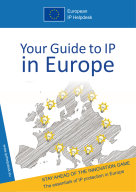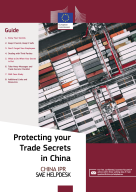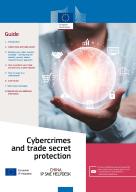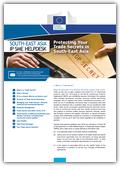Definition
A trade secret is information or know-how developed in the context of business or trade, which meets the following requirements: it is secret – in the sense that it is not generally known among or readily accessible to persons within the circles that normally deal with the kind of information in question, it has commercial value because it is secret, and it has been subject to reasonable steps to keep it secret.
Trade secrets are a valuable resource for many companies whose assets may, for instance, not be patentable and yet have a great commercial value. They can also be used as an alternative to patenting in order to avoid the disclosure that comes with publication. There is no term of expiration for a trade secret: as long as it is duly kept in confidence, a trade secret will be protected and enforceable by its holder. The modalities of enforcement of trade secrets may however vary depending on the legal system.
Resources about trade secrets
European IP Helpdesk

Intellectual property (IP) management is a key element in improving the competitiveness of any company.
China IP Helpdesk

China, like most other countries, provides a legal framework for the protection for trade secrets, and the law provides for remedies in the event that your trade secrets are unlawfully disclosed.

While steps are being taken to fight against cybercrimes, SMEs need to implement appropriate strategies to protect themselves against the theft of valuable information.
India IP Helpdesk

This factsheet provides information on how trade secrets and confidential information are protected in India
Latin America IP Helpdesk

Trade secrets in Latin America in a nutshell
South-East Asia IP Helpdesk

Explore our comprehensive 'Guide to trade secrets protection in South-East Asia': covering trade secret basics and tips across South-East Asia, it’s the key to safeguarding your assets effectively in the region.
NDAs might not be enough in China. Normally companies prefer to sign an NNN agreement. NNN agreements include non-disclosure, non-circumvention, and non-use clauses.
- No use: the company cannot use the product for other purposes than the one settled in the contract.
- No circumvention: to keep the company from competing against you.
- No disclosure: to stop trade secrets from being given to third parties. The contract should be clear enough about what information is considered a trade secret and what the consequences are in case of an information leak.
In trade fairs, companies should only expose those products and brands that were already registered and protected. Not doing this might lead to bad faith registrations from third parties and loss of any potential IP protection. All unprotected IPR should be treated as a trade secret, thus kept away from disclosure in any public event, especially trade fairs.
| Patent | Utility Model | Trade Secret | |
|---|---|---|---|
| Advantages |
|
|
|
| Disadvantages |
|
|
|
All types of information can be exchanged under non-disclosure agreements, such as ideas, know-how, descriptions of inventions, chemical formulas, research or business information and negotiations, among others. The common characteristic, however, is that the disclosed information is valuable to the disclosing party to the extent that it must be kept away from the public domain.
In fact, in the European Union several types of intellectual property rights, in particular patents and industrial designs, demand novelty as a requirement for acquiring protection. In most of the EU countries, a creation is considered new if it has not been previously made available to anyone anywhere, unless under confidence obligations. Moreover, some intellectual assets are generally not patentable in many countries of the European Union, such as methods for doing business, and therefore can only be protected if kept out of the public domain. On the other hand, organisations can strategically decide that keeping information confidential is the most appropriate way of protection. Independently from the reason, in all these scenarios, non-disclosure agreements are the recommended tool to use for the purpose of protecting information when it is necessary to transmit it in confidence.
Thus, it is best practice to conclude a non-disclosure agreement before engaging in negotiations for licence agreements and R&D projects, or whenever necessary to show innovative ideas, products or technologies to potential business partners or other persons. Confidentiality obligations may also be part of a larger agreement, such as license agreements, consortium agreements and employment contracts.
Cambodia has not yet adopted a specific law on trade secrets. However, a draft law is currently being negotiated. Until Cambodia has adopted the Law on Trade Secrets and Undisclosed Information, trade secrets may be protected under other laws. For example, to maintain information in employment or other contractual relationships, a non- disclosure agreement may be used and enforced by the Contract Law of 1998.
No. Inventions can also be protected by simple patents and by trade secrets if you do not disclose any of its information, i.e. keep them as a secret.
Simple patents only apply to products and tools, and not to technologies, which are generally protected as standard patents. These products or tools should be novel and applicable to the industry in question. There are also no strict requirements for an inventive step with a simple patent. The process for obtaining a simple patent is generally shorter than standard patents, however there is a reduced term of protection (10 years from the filing date).
In order to secure trade secret protection, the invention must comply with three (3) general standards: the information is not generally known to the public (confidential), it has an economic value (because it is kept secret), and is the subject of reasonable efforts by the rightful holder of the information to maintain its secrecy (through confidentiality agreements where applicable). There is no need to apply for registration in order to obtain trade secret protection because the regulation itself already confers the protection if the information fulfils the aforementioned conditions. In a trade secrets case, it is necessary to prove that the trade secret has been taken by the suspected party. Proving this might be difficult as litigation proceedings in Indonesia are not equipped with a procedure to uncover relevant evidence.
Publishing an invention may also be an effective market strategy for protection particularly in cases where you do not need to have exclusivity. It is the cheapest option and it has the advantage of blocking others from getting a patent on the same invention. However, remember to take into account that you will be disclosing your innovation to potential competitors.
Latest news

Since January, trade mark applications have had to specify all claimed colors and file in black and white if no color is claimed

In this blog post, we look at the copyright dispute that ruined the studio behind the original 1922 Nosferatu movie. A timeless tale and a reminder to all creators that they must make sure they are not infringing on anyone's copyright when creating their own content, no matter how good it is!

In this post, we look at two trade mark cases of the General Court involving Mercedes-Benz and Schweppes.

DINAPI enables search for registered sound marks
Today, the European Patent Office (EPO) released the Patent Index 2024, which shows that innovation remains strong, with patent applications last year keeping up the high level observed in 2023.
